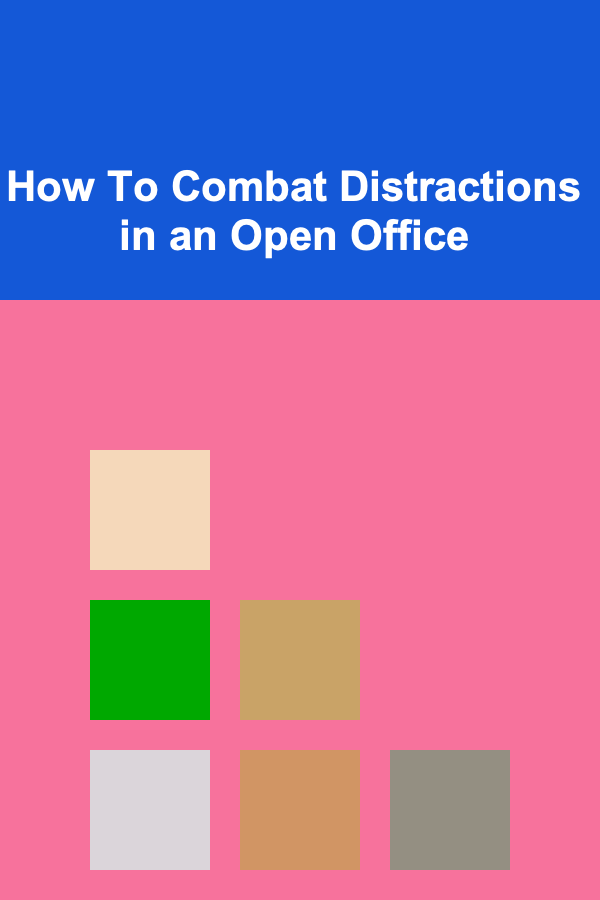
How To Combat Distractions in an Open Office
ebook include PDF & Audio bundle (Micro Guide)
$12.99$9.99
Limited Time Offer! Order within the next:

Open office spaces have become the go-to layout for many modern workplaces, praised for their ability to encourage collaboration, foster transparency, and improve communication. However, while these open environments can have undeniable benefits, they often come with a significant downside: distractions. The very factors that make open offices appealing---such as proximity to colleagues and a lack of physical barriers---can also become sources of interruptions and decreased productivity. Combatting distractions in an open office is essential for maintaining focus, efficiency, and overall job satisfaction.
This article delves into the strategies and techniques to combat distractions in an open office environment. We will explore how understanding the nature of distractions, adopting time-management practices, and utilizing workspace design and technological solutions can mitigate the negative impact of an open office layout. Through a combination of personal habits and organizational adjustments, employees and companies can enhance their work experience and productivity.
The Nature of Distractions in Open Office Spaces
To effectively combat distractions, it's essential first to understand what makes open office environments particularly prone to interruptions.
Types of Distractions in Open Offices
- Auditory Distractions: Conversations, phone calls, and background noise are often the most significant distractions in an open office. In an environment where everyone is within earshot, noise levels tend to increase, and it becomes harder to concentrate on individual tasks.
- Visual Distractions: Since open offices are typically designed with minimal partitions, employees may find themselves constantly exposed to the visual movements of colleagues, whether it's someone walking by, making gestures, or even switching their own workstations.
- Social Interactions: While collaboration is encouraged, unplanned social interactions can be a significant source of distraction. Colleagues may come by to chat about work-related issues, personal matters, or even take extended breaks.
- Digital Distractions: With open spaces often linked to increased use of technology, constant notifications from emails, Slack messages, and social media platforms can pull attention away from the task at hand.
- Lack of Privacy: The absence of private spaces or soundproof barriers can make employees feel uneasy and stressed, especially when it comes to sensitive tasks that require deep focus or personal conversations.
- Frequent Interruptions: With open layouts, it's easy for coworkers to walk up to someone's desk, ask questions, or interrupt their workflow. These frequent disruptions can significantly lower productivity and concentration.
The Impact of Distractions on Productivity
Distractions in open offices have been linked to lower levels of job satisfaction, increased stress, and reduced productivity. According to studies, it takes an average of 23 minutes to return to a task after being interrupted. For employees who are frequently disturbed by phone calls, casual conversations, or even background noise, this time loss can accumulate throughout the day, leading to substantial decreases in overall output.
Moreover, research shows that constant distractions not only hinder cognitive performance but also contribute to burnout. Employees in open offices often report feeling mentally fatigued at the end of the day, as their focus is frequently fragmented, leaving them unable to engage in deep, meaningful work.
Strategies to Combat Distractions in Open Offices
While the challenges posed by open offices are significant, there are numerous strategies that both individuals and organizations can adopt to minimize distractions and improve productivity.
1. Set Boundaries with Colleagues
One of the simplest and most effective ways to combat distractions is to establish clear boundaries with coworkers. Respecting personal space and communication preferences is key to fostering a distraction-free work environment.
Communicate Your Needs
Let your colleagues know when you need uninterrupted time. This could involve explicitly stating that you prefer not to be disturbed for certain tasks or using non-verbal cues such as wearing headphones or closing your computer screen.
Use "Do Not Disturb" Signals
In many open office settings, employees adopt visible cues to signal that they are in a focused state and should not be interrupted. These signals can include wearing noise-canceling headphones, placing a "Do Not Disturb" sign on your desk, or even adjusting your seating arrangement to avoid being approached.
Scheduling Focused Time
Designating specific hours of the day for focused work is another strategy. This could be achieved through calendar blocking, where employees schedule blocks of time for deep work and inform others that they are unavailable during these periods. It can also help to coordinate with colleagues to minimize disruptions during these hours.
2. Create Personal Quiet Zones
Incorporating personal space where employees can retreat for focused work is a highly effective way to combat distractions. While open offices are typically designed for collaboration, personal quiet zones or breakout rooms can provide employees with a place to concentrate without the usual disturbances.
Soundproofing and Acoustic Solutions
For those who do not have access to separate rooms, investing in soundproofing tools can make a big difference. This includes using noise-canceling headphones, desk partitions, or even acoustic panels to reduce background noise and create a more private work environment.
Some companies also invest in acoustic design elements within their office layout, such as cushioned flooring or ceiling panels, which help reduce the overall noise level. Such adjustments can reduce the cognitive load caused by auditory distractions and allow employees to concentrate better.
Private Workspaces or Pods
Designing small, semi-private work pods is another viable solution. These pods or booths are soundproofed, enclosed spaces where employees can escape the hustle and bustle of the open office, offering a distraction-free zone for focused work or private conversations.
3. Use Time-Blocking Techniques
Time management plays a crucial role in combatting distractions. By organizing tasks into designated time blocks, employees can allocate uninterrupted periods to high-priority tasks and use breaks to recharge.
The Pomodoro Technique
The Pomodoro Technique, which involves working in 25-minute intervals followed by 5-minute breaks, is an excellent way to maintain focus in an open office environment. This technique encourages short bursts of intense work followed by rest periods, helping to manage both physical and mental fatigue.
Time Blocking for Deep Work
For those involved in tasks that require prolonged concentration, such as writing reports or coding, time-blocking can be an effective way to ensure dedicated time for deep work. By setting clear boundaries for when these tasks will be done (e.g., in the morning when the office is quieter), employees can limit interruptions during these crucial periods.
4. Leverage Technology for Focus
In today's digital world, technology can be both a blessing and a curse. While digital tools can distract, they can also be harnessed to increase focus and productivity.
Distraction-Free Apps and Tools
Numerous apps and browser extensions are designed to help workers stay focused by blocking distracting websites or apps during work hours. Some popular examples include:
- Forest: An app that rewards users for staying focused by planting virtual trees.
- Freedom: A website-blocking tool that allows users to block distracting websites across all devices.
- Focus@Will: A music service that provides background soundtracks designed to improve concentration.
Use of Collaborative Tools
Open offices can sometimes blur the lines between individual and group work. Using collaborative tools like Slack, Microsoft Teams, or Trello can streamline communication and minimize the need for spontaneous interactions. By directing communication into structured channels, employees can avoid casual interruptions while still engaging in teamwork.
Digital "Do Not Disturb" Modes
Most communication platforms have a "Do Not Disturb" feature that allows employees to turn off notifications during critical work hours. Activating these features can help employees avoid being interrupted by constant emails or message notifications, allowing them to focus on their tasks.
5. Optimize the Office Layout and Design
Organizations themselves must play an active role in mitigating distractions. The physical design of the office space can have a major impact on the ability of employees to concentrate.
Flexible and Zoning Spaces
One way to reduce distractions in an open office is through flexible workspaces. Instead of having everyone in the same room, companies can create zones designed for different types of work. Quiet zones for focused tasks, collaborative spaces for brainstorming, and lounge areas for informal meetings can help to separate tasks and minimize unnecessary distractions.
Ergonomics and Comfort
Comfortable workstations also play a role in reducing distractions. Ensuring that employees have ergonomic furniture, proper lighting, and temperature control helps to create a space conducive to concentration. Employees who are physically comfortable are less likely to be distracted by discomfort, which can increase their ability to focus.
6. Encourage Breaks and Downtime
While minimizing distractions is essential, it's also crucial to recognize that rest and recovery play a major role in sustaining productivity. In an open office, employees may feel the pressure to constantly stay engaged, which can lead to burnout. Encouraging regular breaks and downtime is necessary to maintain focus and performance.
The Importance of Movement
Short breaks to walk around, stretch, or get fresh air are critical for mental and physical health. Not only do breaks provide much-needed relaxation, but they also allow the brain to reset, making it easier to focus when returning to work.
7. Lead by Example
Finally, leadership plays a key role in setting the tone for how to handle distractions in the office. Managers and team leaders should model productive behaviors by using the strategies outlined above and encouraging employees to prioritize focus and respect one another's need for quiet time.
Conclusion
Distractions in open office environments are inevitable, but they do not have to hinder productivity. By setting boundaries, creating quiet zones, managing time effectively, leveraging technology, optimizing office design, and encouraging breaks, employees and organizations can take proactive steps to minimize interruptions. In doing so, they can foster a work environment where employees can thrive, produce high-quality work, and maintain a healthy work-life balance.
In the end, an open office can remain a space for collaboration, creativity, and transparency, but only when distractions are thoughtfully managed and productivity is prioritized. By addressing distractions head-on, organizations can create a more efficient and enjoyable workspace for everyone.

How to Budget for Holiday Spending
Read More
How to Build a Checklist for Natural Disaster Preparedness
Read More
How to Create a Holiday Playlist for the Perfect Atmosphere
Read More
How to Improve Tenant Retention in Your Rental Property
Read More
How to Use Spreadsheets to Stay Organized Throughout Wedding Planning
Read More
Ways to Monetize Your Deep Learning Skills and Knowledge
Read MoreOther Products

How to Budget for Holiday Spending
Read More
How to Build a Checklist for Natural Disaster Preparedness
Read More
How to Create a Holiday Playlist for the Perfect Atmosphere
Read More
How to Improve Tenant Retention in Your Rental Property
Read More
How to Use Spreadsheets to Stay Organized Throughout Wedding Planning
Read More